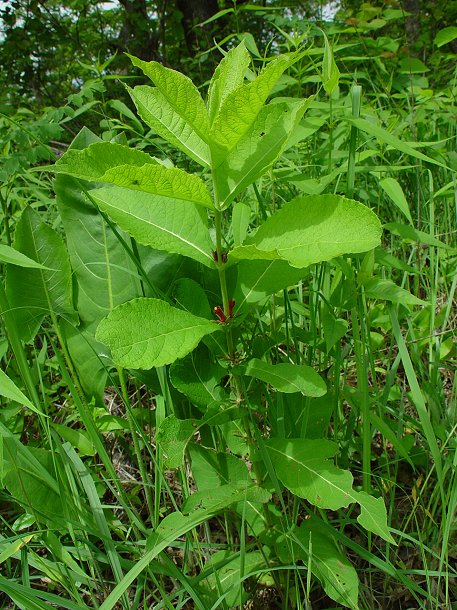Triosteum perfoliatum L.
Common Horse Gentian

Native
CC = 4
CW = 5
MOC = 66
© DETenaglia
Triosteum perfoliatum L.Common Horse Gentian | |
 |
Native CC = 4 CW = 5 MOC = 66 |
© DETenaglia |
|
Family - Caprifoliaceae Habit - Perennial forb. Stems - Ascending to erect, to 1.2 m, single or multiple from the base, densely pubescent with short (0.3-0.5 mm), softer hairs that are mostly minutely gland-tipped and also sparse straight, more or less spreading, longer, bristly hairs 1.0-1.5 mm long.
Leaves - Opposite, sessile. Median 3-5 leaf pairs usually moderately to strongly perfoliate, these 1-6 cm wide at the base. Leaf blades 9-20 cm long, 4-9 cm wide, oblanceolate to obovate or elliptic, those of the largest leaves occasionally fiddle-shaped, the nonperfoliate leaves tapered at the base, sometimes to an indistinct, broadly winged petiolar base, tapered to a sharply pointed tip, the margins with relatively dense, stiff, ascending hairs, the upper surface moderately pubescent with short, straight, appressed hairs, the undersurface moderately to densely pubescent with short, soft, spreading hairs mostly along the veins. Venation expressed abaxially.
Inflorescence - 1 or more commonly 2 or 3 per leaf axil (2-6 per node). Paired bracts subtending each flower sometimes longer than the ovary but shorter than the flower (including the calyx and corolla), linear to narrowly lanceolate. Flowers - Calyx lobes 10-18 mm long, the inner and outer surfaces with scattered, short hairs, some of these often minutely gland-tipped. Corollas 8-17 mm long, dull red to purplish red, often mottled with small, cream-colored spots near the base and on the inner surface, occasionally entirely greenish yellow, narrowly funnelform, the mouth only slightly oblique, the outer surface with gland-tipped hairs, gibbous at the base with a small reservoir for collecting nectar. Stamens 5, alternating with the corolla lobes, attached along the entire length on the corolla tube, included. Filaments free for half their length, pubescent, yellow. Anthers yellow, 4-5 mm long. Styles usually slightly to moderately exserted (to 5 mm beyond the corolla lobes). Stigma capitate, 4-lobed, 2-3 mm broad. Ovary inferior.
Fruits - 7-10 mm, yellow to orange, sparsely hairy at maturity.
Flowering - May - July. Habitat - Forests, bases and ledges of bluffs, edges of glades, streambanks, roadsides. Origin - Native to the U.S. Lookalikes - T. aurantiacum, T. angustifolium. Other info. - This attractive species can be found throughout Missouri except in the extreme southeastern corner of the state. It occurs throughout most of the eastern half of the continental U.S., most frequently in the upper Midwest. Photographs taken in Eminence, MO., 5-23-03 (DETenaglia); also at Cuivre River State Park, Lincoln County, MO, 8-16-2010, and at Glassberg Conservation Area, Jefferson County, MO, 5-26-2017 (SRTurner). |